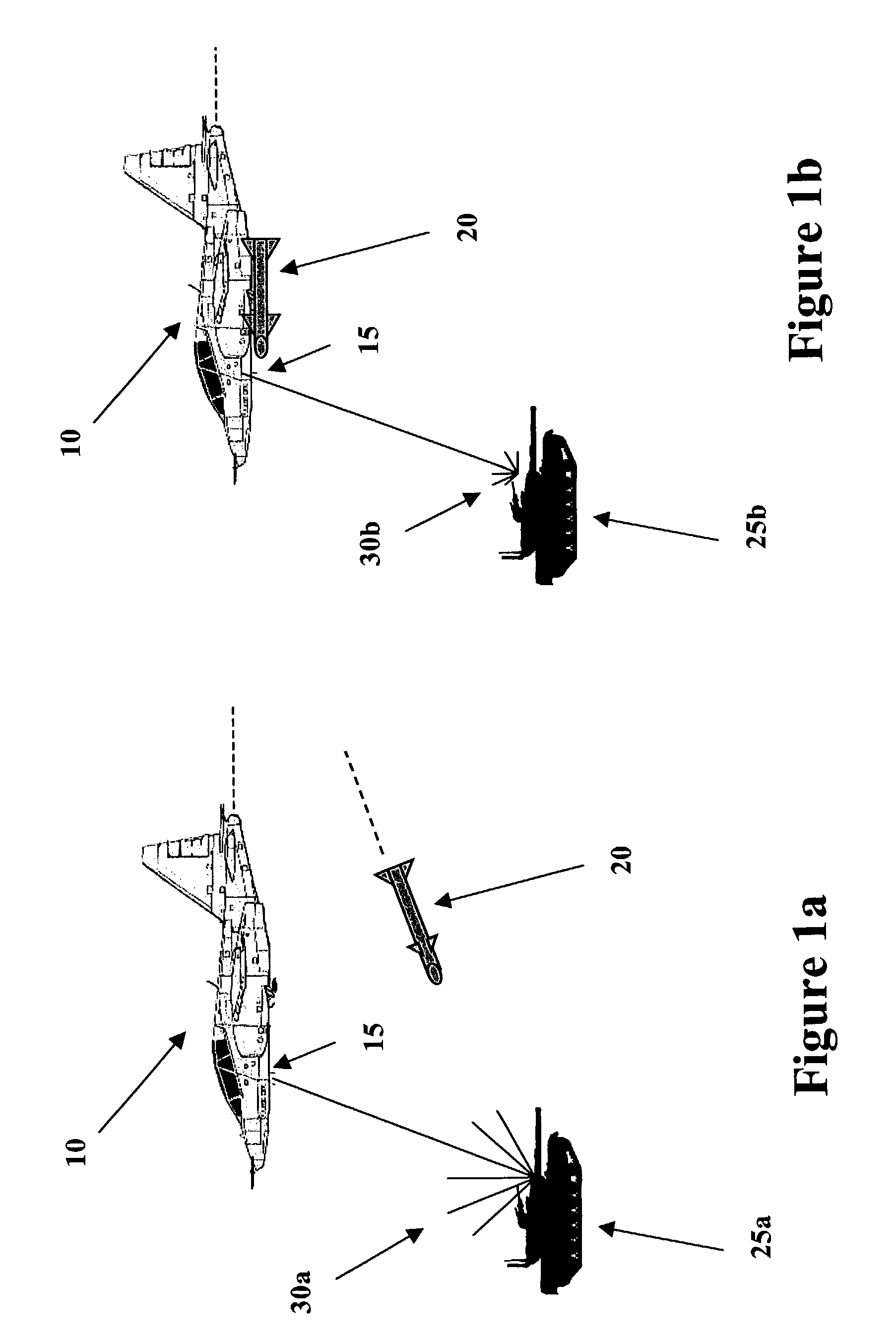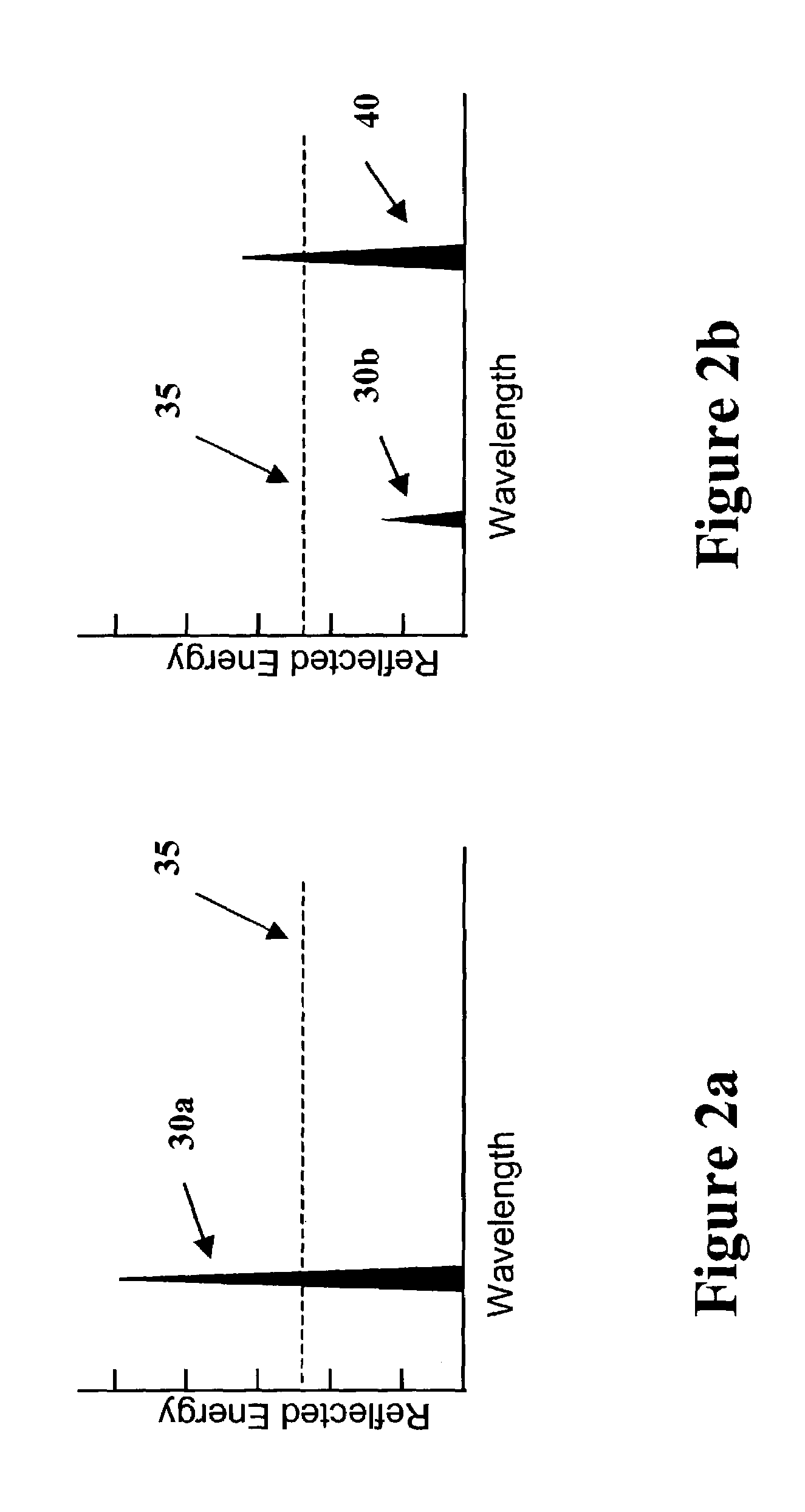Method and system for countering laser technology
a laser technology and laser technology, applied in the field of laser technology countermeasures, can solve the problems of high cost, environmental constraints, and current cloaking technologies, e.g., based on organic dyes, rare earth materials and fluorescent pigments, and achieve the effect of facilitating the addition of the first nanocomponent material
- Summary
- Abstract
- Description
- Claims
- Application Information
AI Technical Summary
Benefits of technology
Problems solved by technology
Method used
Image
Examples
first embodiment
[0026]In comparison, utilizing the cloaking system and method of the present invention, FIG. 1b illustrates the situation wherein the laser radiation 15 transmitted from plane 10 is mostly absorbed by the target and / or the reflected laser radiation 30b is (a) below the S:N ratio of the detector within the laser beam-rider weapon 20, (b) reflected at one or more wavelengths that are not detectable by the detector within the laser beam-rider weapon 20, or (c) a combination of (a) and (b). FIG. 2b shows the reflected laser radiation 30b from the target 25b falling below the S:N ratio 35 for the detector within the laser beam-rider weapon 20 and down-converted reflected laser radiation 40. Down-converted reflected laser radiation 40, though above the S:N ratio 35 required by the detector within the laser beam-rider weapon 20, is not within the range of detectable wavelengths, and this is not detected by the laser beam-rider weapon 20. As shown in FIG. 1b, the laser beam-rider weapon 20 ...
second embodiment
[0032]In the present invention, different sets of nanodots having different absorption and emission wavelengths are utilized in a countermeasure method and system that includes both cloaking and decoying. More specifically, in for example, a combat situation where numerous tanks, trucks, and other potential convoy targets may be targeted by a laser beam-rider weapon, targets containing actual supplies, weapons, humans, etc. are coated with cloaking nanodots, i.e., nanodots that are tailored to absorb the transmitted laser radiation and reflect the detectable reflection wavelength at below threshold levels and emit reflected radiation in an undetectable wavelength due to down-conversion of the transmitted laser radiation. At the same time, remotely controlled decoy targets that do not contain actual supplies, weapons or humans are coated with nanodots specifically tailored to absorb the transmitted radiation and emit the reflected radiation specifically within the wavelength of the d...
third embodiment
[0033]In the present invention, tailored nanodots are utilized as an obscurant in order to counteract the blinding effects of certain lasers. In a particular example, the nanodots are tailored to absorb the transmitted laser radiation as described above and then the nanodots are encapsulated due to their small size, i.e., on the order of a couple of angstroms. The incorporation or encapsulation may be within a polymer, e.g., a polymer matrix such as polystyrene or PMMA (Polymethylmethacrylate). The encapsulated nanodots are on the order of 1 up to 100 microns. This size is significant due to the fact that nanodots of this size will have the characteristics of a gaseous medium and behave as a gas when released into the air. The encapsulated nanodots are then released in the vicinity of or ahead of the targeted individuals seeking to avoid temporary blindness in order to absorb the transmitted laser radiation prior to it reaching the targeted individuals. The encapsulated nanodots may...
PUM
| Property | Measurement | Unit |
|---|---|---|
| Diameter | aaaaa | aaaaa |
| Diameter | aaaaa | aaaaa |
| Diameter | aaaaa | aaaaa |
Abstract
Description
Claims
Application Information
 Login to View More
Login to View More - R&D
- Intellectual Property
- Life Sciences
- Materials
- Tech Scout
- Unparalleled Data Quality
- Higher Quality Content
- 60% Fewer Hallucinations
Browse by: Latest US Patents, China's latest patents, Technical Efficacy Thesaurus, Application Domain, Technology Topic, Popular Technical Reports.
© 2025 PatSnap. All rights reserved.Legal|Privacy policy|Modern Slavery Act Transparency Statement|Sitemap|About US| Contact US: help@patsnap.com



